The deer camp crew from New England Adventures poses for the only group shot of the weekend, with Nate’s doe. Little Outdoor Giants
I’m leaning against a tree in a stand of white oak, sugar maple, hemlock, and beech trees with a Marine corporal in his mid-30s named Nate.
We’re quiet, still, and hyper-vigilant of our surroundings—we’re searching hard for any movement in the woods before us. And for the first time, deer hunting strikes me as a proxy for military guard duty. It’s late fall in the Berkshires of western Massachusetts. Along with a handful of veterans from around the state, Nate and I are on the last hunt of the year led by a group called New England Adventures (NEA).
Founded by an Iraq War vet named Todd Crevier, the organization sponsors year-round hunting and fishing expeditions for veterans and their families.
It’s not snowing yet, but it might, and we’re all hoping for a fresh blanket of tracking snow. For now, our group is sitting tight at various points around 89 acres of private land made available to NEA by a local family with a Marine Corps history. This gives Nate and me a chance to get to know each other through whispers while we scan for deer.
After completing Close Quarters Battle school in Virginia—“We were blowing through 10,000 rounds a week”—Nate did two tours in Fallujah during the worst of the action there. He was a squad leader, one of those guys you see portrayed in movies who is kicking down doors and storming houses in search of enemy insurgents.
When he left the Marines in 2006, at age 23, Nate began a long-planned career in law enforcement. But that didn’t work out. Too quick to act, too much force. He found the new rules of engagement too restrictive to manage.
“Marines tend to stay hardcore,” Nate says.
His resignation from his town’s police force was his low point, and a shroud of isolation descended upon him.

The deer camp crew from New England Adventures poses for the only group shot of the weekend, with Nate’s doe. Little Outdoor Giants
“You lose your profession, you lose your identity, you lose your self-worth,” he murmurs as we sit in the woods.
Crevier invited me on this hunt to help tell a story that many folks don’t want to read—the story of the ongoing battle that our military vets are fighting to claw their way back into civilian life, all while falling victim to an opioid epidemic that has rocked small-town America.
Nate was selected for an NEA hunt in 2016, and shortly after he joined the organization. He now serves as the de facto logistics coordinator. The night before our hunt begins, he presents a detailed mission briefing—personnel, topography, safety, weather, objectives—that functions as a potent callback to military service.
For three nights, 10 or so guys sit around a 1950s-built cabin smoking cigarettes, drinking beer, comparing ink, and calling into question various anatomical or cerebral shortcomings of rival service branches. (“Someone explain to this Marine what ‘cerebral’ means.”) All of these guys’ stories are familiar, yet each includes its own unique heartbreak. Along with the jokes and wisecracks, there’s real talk, and real stories.
Kevin Padberg, who served for 23 years in the Air Force, tells me one afternoon: “I hate those yellow ribbons. I f—ing hate ’em. I can’t say that to people on the street. I know they have good intentions. But here, with other vets, I can say that sort of thing.”
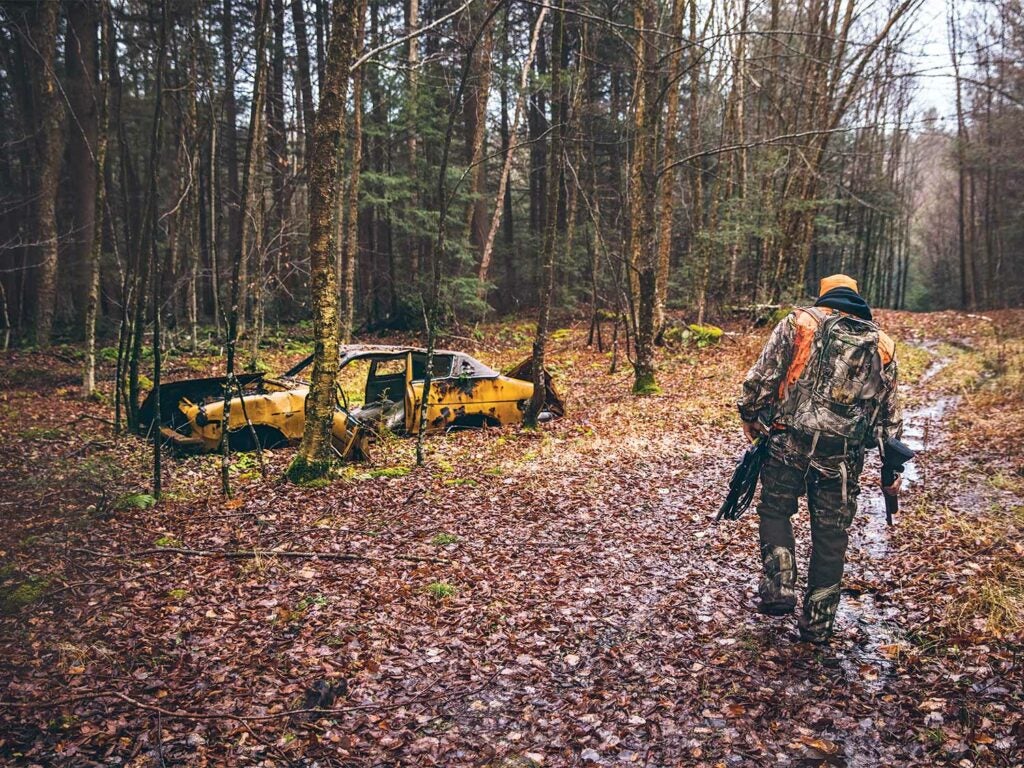
Walking past an abandoned, rusted-out car on the way to the stand for an evening sit. Little Outdoor Giants
From Soldier to Addict
On September 11, 2001, Crevier watched the television coverage as the Twin Towers burned and collapsed. Like all of us, he was outraged. Then he did something few of us did. He enlisted in the U.S. Army. By October, Crevier was going through basic training at Fort Jackson, South Carolina.
Crevier was 25 at the time. A college grad, married, employed, with a 4-year-old son. Everyone thought he was crazy. “My wife lost her mind,” he says.
No surprise to those who knew him, Crevier turned out to be an exceptional soldier. He earned a Bronze Star and rapidly rose to sergeant first class. Among the more harrowing jobs he volunteered for during his 2004 tour of Iraq was riding shotgun for fuel convoys, one of the juiciest, slowest-moving targets for enemy fighters.
“Our job was to provide security for 5,000-gallon trucks hauling fuel all over Iraq,” Crevier says.
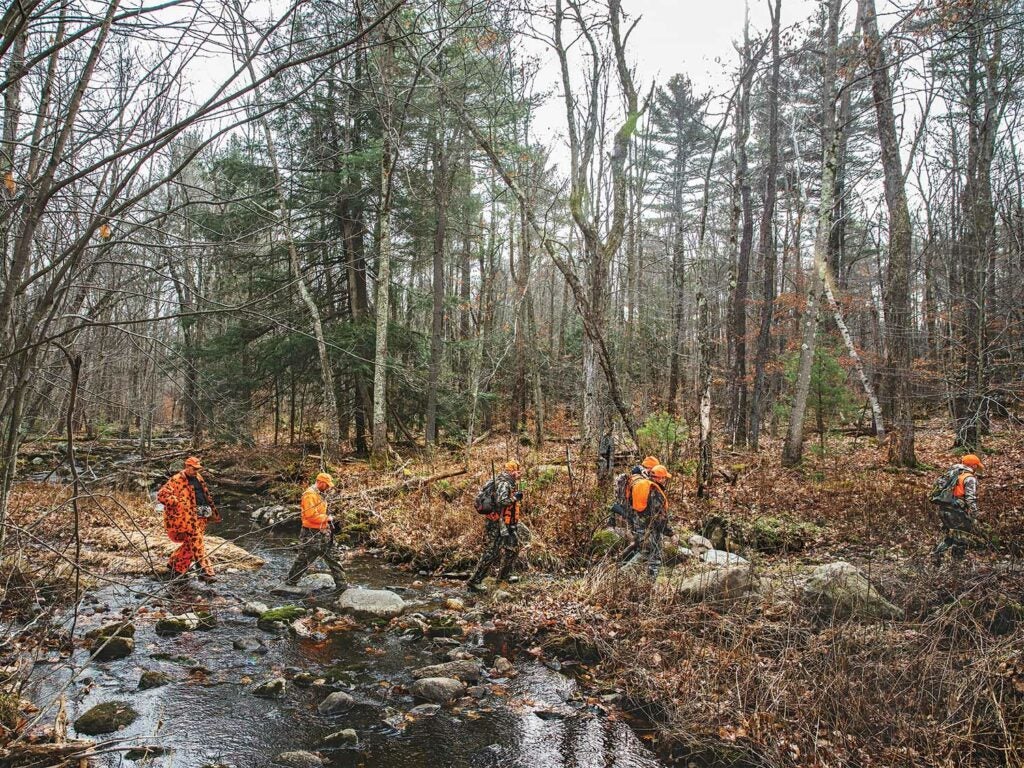
Crossing a creek to set up for an old-fashioned deer drive. Little Outdoor Giants
He racked up 150 missions, logging 30,000 miles around Iraq, many manning a .50-caliber machine gun mounted atop the cab of a bobtail truck. “Two-hundred-mile round-trips. Drive one way, gun the other.” He preferred gunning on morning legs. By afternoon, the 100-plus-degree temperatures were murder.
Crevier was nearly killed when an RPG tore through the fuel hauler in front of him. Another time, after a mission debriefing, he turned one way down a street on a base, his platoon sergeant went the other. A minute later a rocket flew over the base wall and tore the sergeant’s leg off.
“It was a miserable existence, but we were doing something bigger than ourselves,” Crevier says. “I loved the Army.”
Being jostled around a truck with anywhere from 40 to 100 pounds of “go to war” gear strapped to their bodies literally compresses soldiers’ spines. Troops retiring with musculoskeletal conditions grew tenfold between 2003 and 2009, according to the Department of Veterans Affairs.
Crevier calls it “slow, consistent trauma.” Among the afflictions he was diagnosed with were spinal stenosis, a herniated disc, arthritis in his hip, skin cancer, kidney stones, stage 2 hypertension, central serous retinopathy that left him legally blind in one eye, and severe PTSD.
The Army began treating Crevier’s back pain in 2010. “They started sending me these big vitamin-pill-sized bottles of pain meds every month. Within six months, I was fully addicted.”
His body adjusted to the drugs. Dosages increased. Crevier became what he calls “a functional addict,” but his health plummeted. In 2013, he was informed that the Army planned to medically retire him.
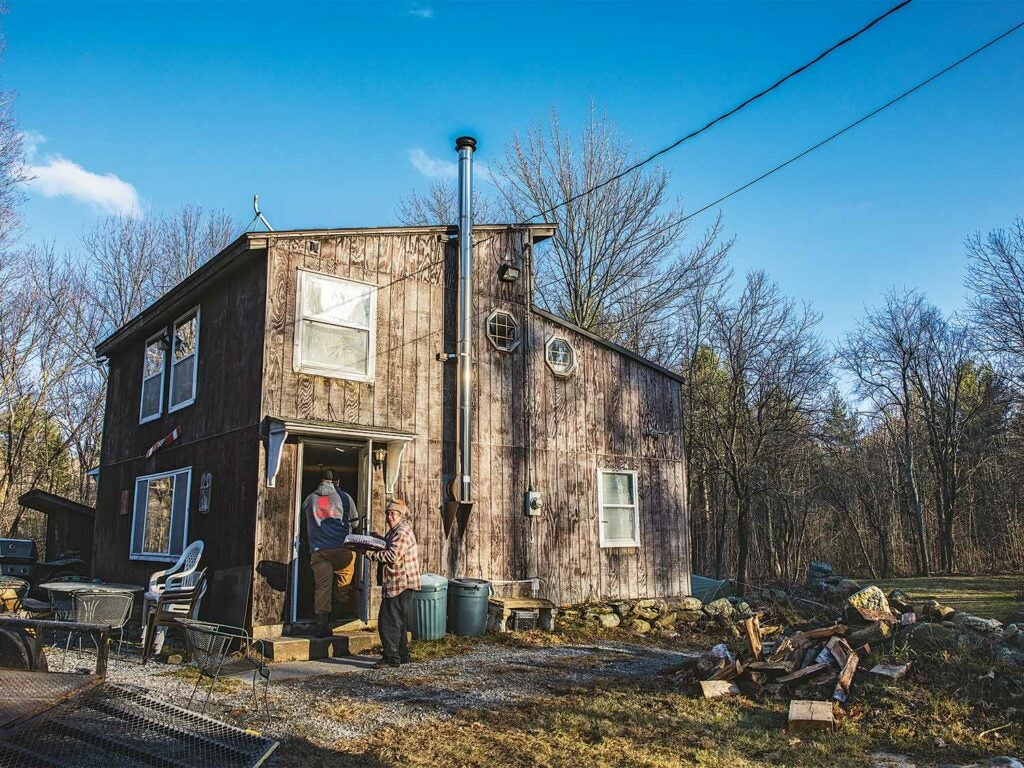
The classic New England deer camp. Little Outdoor Giants
“I was broken. They had no use for me,” Crevier says. “October 6, 2014, was my last day in uniform. Worst day of my life. The Army was my identity.”
As a civilian, his drug use increased. A bumpy marriage finally ended in divorce. So did a second. He lost jobs he was overqualified for, and was told by one supervisor he wasn’t relating well to co-workers.
The only thing keeping him alive—so he came to believe—were the giant bottles of opioid painkillers the VA sent him each month. Vicodin. Percocet. Tramadol. A lot of people don’t realize these are all simply forms of pharmaceutical-grade heroin. Merciless rapture.
“At the height of my addiction I was on 15 different meds—one to go to sleep, one to wake up, one for anxiety, one to stop nausea, one to keep me from killing myself, three or four for pain management—I was literally carrying around a shopping bag full of pills everywhere I went,” he says.
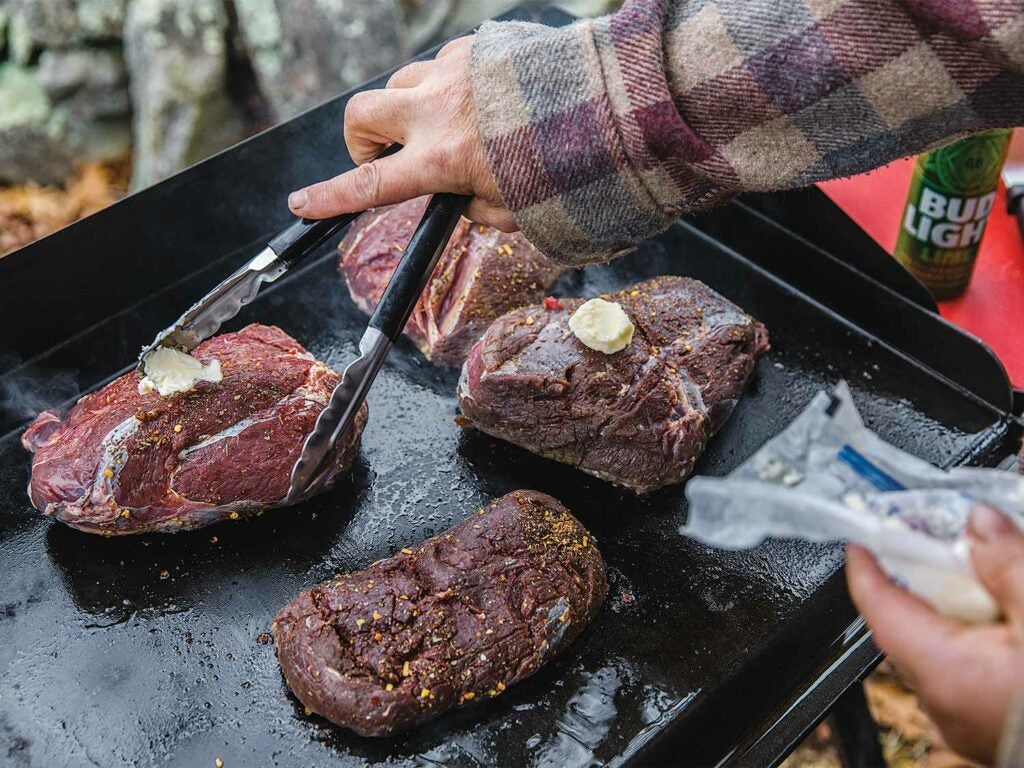
Venison on the grill. Little Outdoor Giants
A Countryside in Crisis
The opioid epidemic that’s ravaged America has dovetailed with our wars in the Middle East, exploiting a special vulnerability among our vets. From the start of military operations in Afghanistan in 2001 until 2013, prescriptions for opiates spiked by 270 percent, leading to addictions and a fatal overdose rate among veterans that was twice the national average, according to a Frontline report. The VA reported that some 68,000 veterans were addicted to opioids between 2010 and 2015.
All the guys at deer camp are familiar with the effects that this crisis has had on our military. They’ve either experienced it themselves or seen the impact on the lives of their buddies.
Anthony Davy, 36, is the youngest member of our party and a Marine Corps infantryman who did force recon in Iraq and Afghanistan. He had never hunted until two months ago, then he discovered bowhunting, and now he brings to the trip the infectious zeal of a convert—his wicked Bahstahn accent amuses even the other Massachusetts guys. Though Davy never became addicted to opioids, he recounts his own difficulties recalibrating to the civilian world.
“When I got home, I felt lost and alone, like I had no purpose anymore,” he says one night while hanging around camp. “When I was serving, I could fall asleep anywhere, anytime. When I got home, there would be times I was up for days. So I drank so I could pass out and sleep finally.”
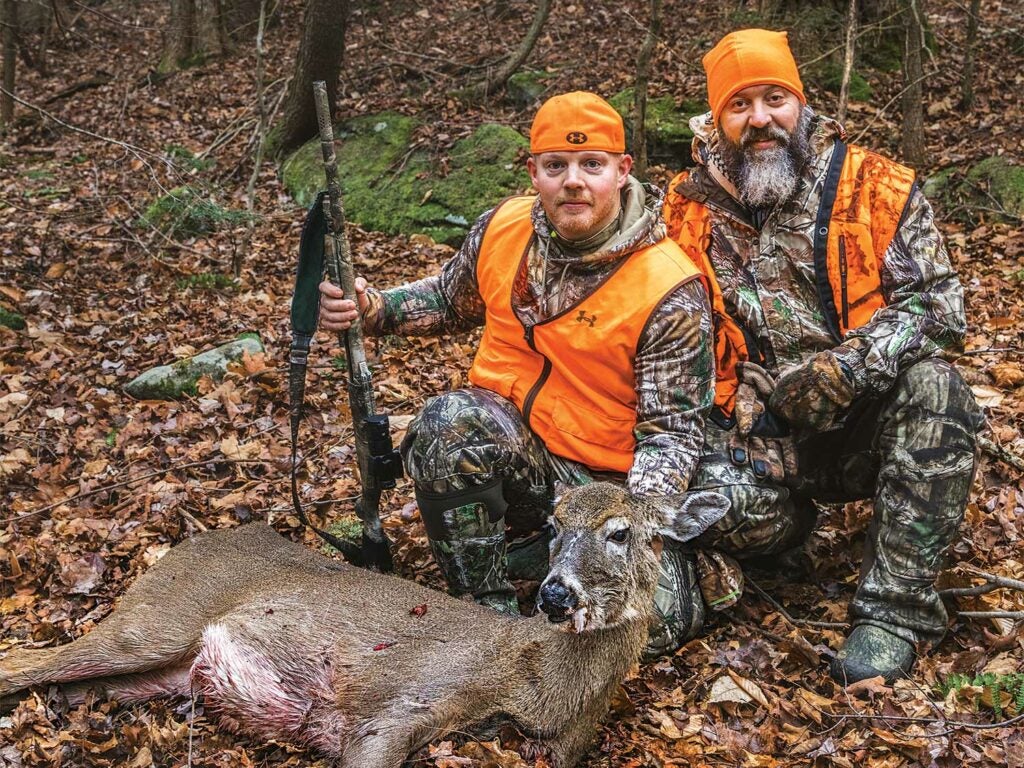
Nate (left) and Todd Crevier with the doe that was taken on the last morning of the hunt. Little Outdoor Giants
It’s a familiar story to vets. Many, like Crevier, turn to drugs just to give their bodies and minds a shred of relief.
Opioids are responsible for more than 33,000 deaths a year, and rural America has been hit particularly hard. In 2006, the Centers for Disease Control and Prevention reported that, for the first time, drug overdose death rates in rural areas had surpassed those in big cities. Vets tend to live in rural and smaller metro areas. Roughly 1 in 12 civilian adults is a vet, but in some smaller metros that figure is as high as 1 in 5, according to housing website Trulia. In New York City and L.A., vets make up less than 5 percent of the population.
Residents in rural areas often find it harder to get help for addiction problems. Services are fewer and farther between, anonymity more difficult to ensure. Stigmas often frame substance-use disorders as a physical weakness or moral failure, discouraging vets from seeking treatment.
“These are not bad people, they’re not criminals,” says Tim Moran, a Navy veteran turned VA nurse in Massachusetts who deals with addiction and PTSD patients. “They may even have some felonies because they did whatever they had to do to get their drug of choice, but they are not criminals by nature. Their bodies are just craving opioids. They think the opioid is the only thing holding them together when actually it’s tearing them apart.”
READ NEXT: Want to Honor Our Military Veterans? Take Them Hunting
The Comeback
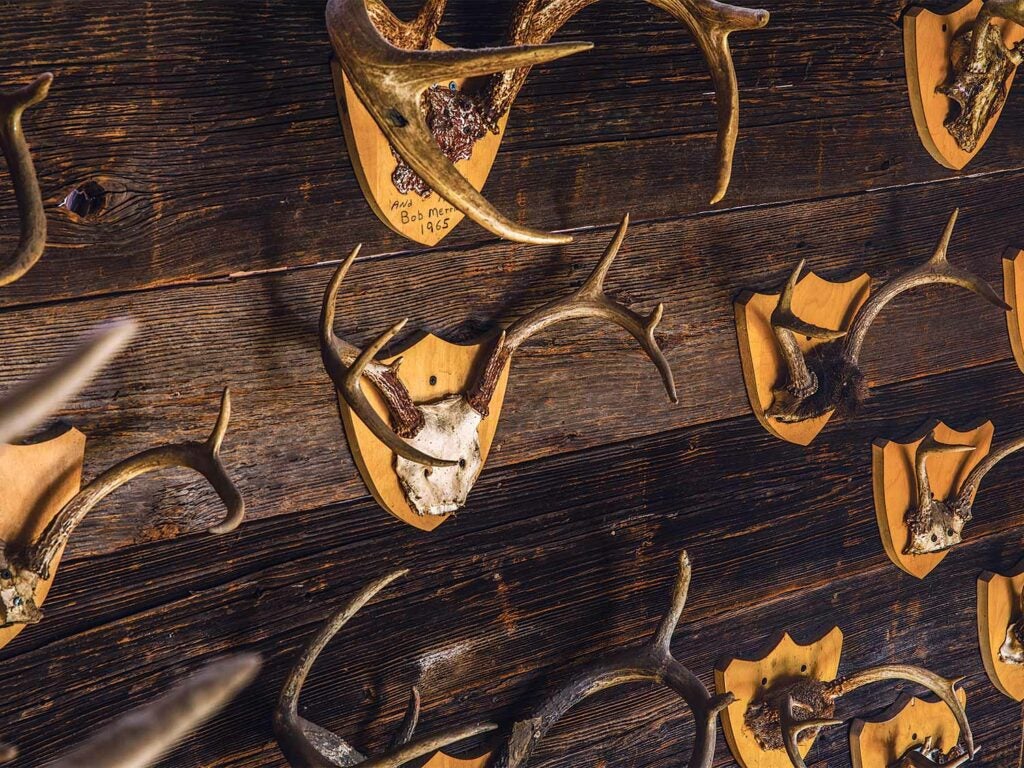
Racks from seasons past. Little Outdoor Giants
By July 2015, back in his hometown of Southwick (population 9,502), Massachusetts, on the fringes of the Berkshires, Crevier realized he was either going to die young or go cold turkey.
“I took my bag of meds to the VA doc and said, ‘I’m all done,’” he recalls. “She answered, ‘It doesn’t work like that. It takes years to wean off them.’ The VA’s number-one thing is, ‘Let’s put a pill in your mouth.’”
For Crevier, detox was excruciating. “I thought I was going to die, I wanted to die,” he says. But he found his way to the other side. Weeks later, clean but still on shaky footing, he took his family on a trip to Yellowstone National Park.
“That was the first time I’d been that far west,” he says. “There’s something so spiritual about Yellowstone. Right there, it was clear to me that I had to stop thinking about doing something and actually do it.”
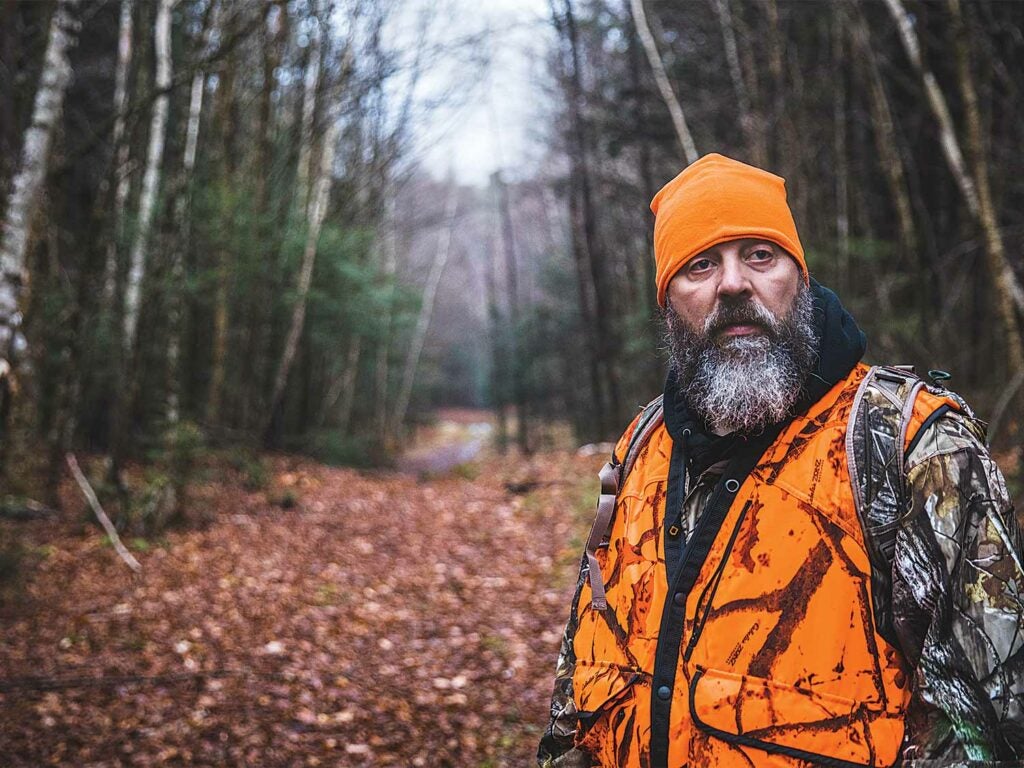
Crevier waits for the crew. Little Outdoor Giants
A lifelong outdoorsman, Crevier had thought for years about starting an organization that would bring veterans together around hunting, fishing, and outdoor activities. Dozens of such groups exist around the country. But for the 950,000 veterans in the six New England states, the closest he could find was located in Ohio. New England Adventures morphed from dream to reality.
Crevier went to work raising money, shaking every bush he could find. The nonprofit’s first big event, a bear hunt in Maine in 2016, provided free trips to four vets. Its annual calendar now revolves around regular hunting and fishing excursions—200 vets and 200 family members have taken part in programs so far—and an annual wild-game dinner and fundraiser auction.
“We never talk about therapy. It’s not mentioned in any of our literature,” Crevier says. “Guys won’t come out for that. But a helluva lot of therapy happens on our trips.”
First Blood
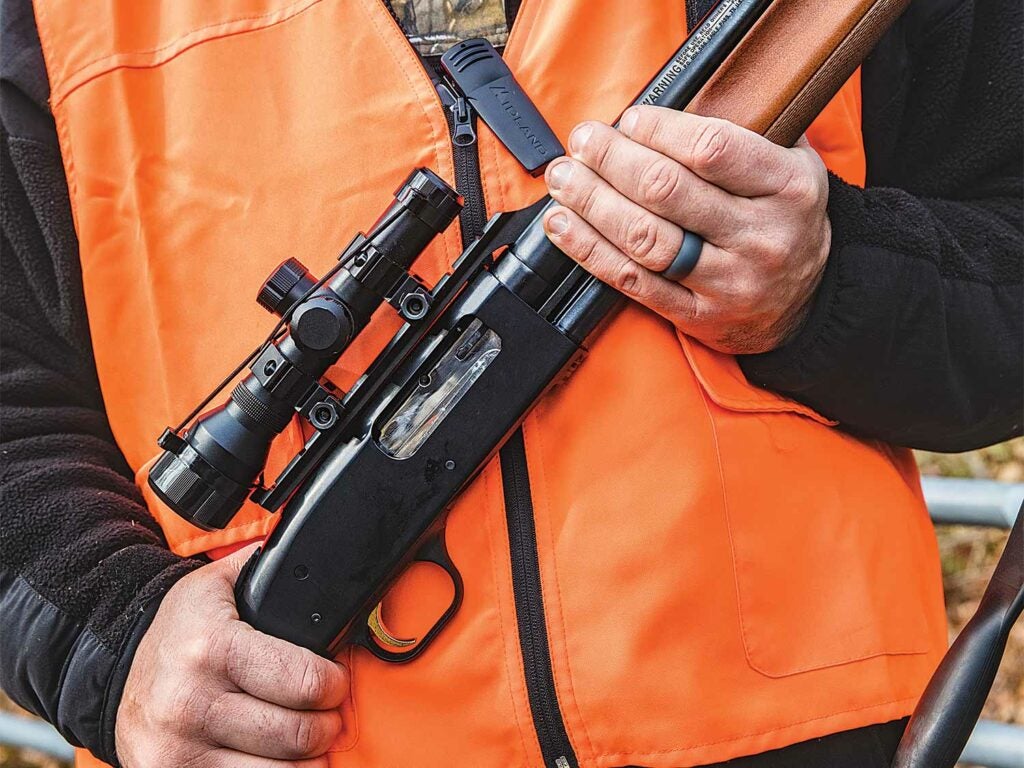
A slug gun ready for action. Little Outdoor Giants
Nate and I don’t fire a shot that first morning, and the hunting is tough all weekend long. But the Marine will keep our group from being skunked. Just after light on the last morning, Crevier and I hear two quick reports from Nate’s Mossberg 500 echo through the forest.
We make our way to Nate’s position and follow a blood trail to find him field dressing a doe. At the top of a low slope, Nate had watched a large doe’s tentative approach up a dry gully. Even in leafless late autumn, the Berkshires are dense, and sightlines are limited. Nate waited like a ghost, but with the first mere thought of raising his barrel, the doe spooked. He shot twice, from 50, then 75 yards—reactions still at fire-team level—and she piled up next to a fallen log.

Nate’s doe. Little Outdoor Giants
“She got within 15 yards, but not with a clear shot,” he says matter-of-factly as we help him work on the deer. “As soon as I moved my arm, she bolted down that grade.”
Back at the cabin, everyone is amped. It’s Nate’s deer, but the group rallies for a communal celebration. It’s not planned or set up—everyone just instinctively gathers around Nate and the deer for the weekend’s only group photo.
“This is what it’s all about for me,” a smiling Crevier tells me. “A bunch of guys who’d never met each other before this week coming together. In some ways, that’s more powerful than any drug.”
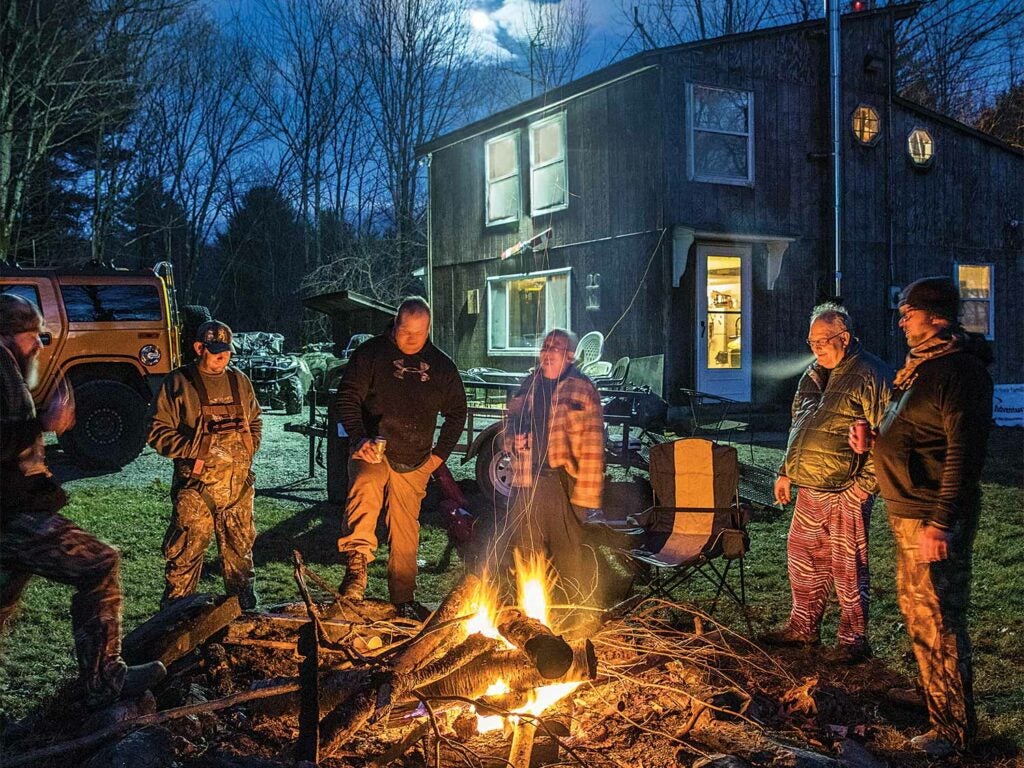
Telling stories and cracking cold ones around the fire. Little Outdoor Giants
I’m the first one out of camp to catch a midday flight back to the West Coast. Only a few miles from where the rest of the guys are planning a deer drive that afternoon, I pull over at a roadside plaque commemorating Gen. Henry Knox.
In the winter of 1775, through these same snowy woods, the former bookstore owner delivered a train of 120 artillery pieces by ox-drawn sleds from Fort Ticonderoga to Cambridge, more than 300 miles away. The guns, and the heroic effort of the grunts on that mission, allowed George Washington to force the British Army to evacuate Boston. The history of America’s warriors in the New England wilderness is a long one. I snap a pic of the plaque.
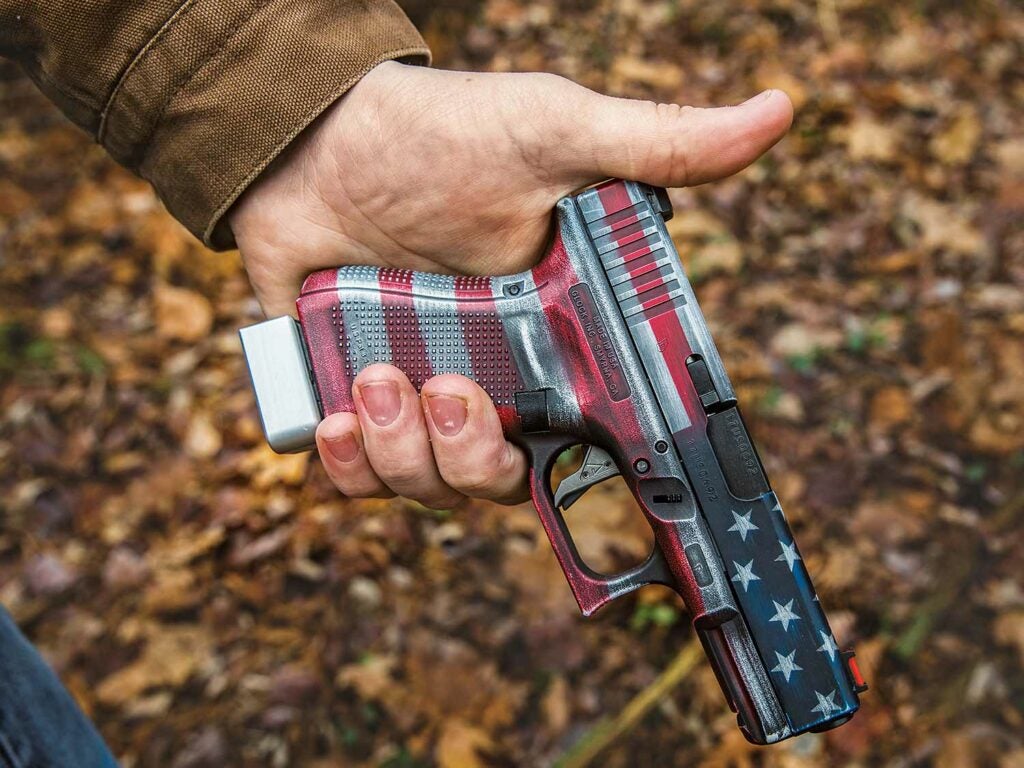
’Merica paint job. Little Outdoor Giants
Maybe the hunt with the NEA vets has rubbed off on me. Or maybe it’s just that I left camp in such a rush that I’m still in my camo. Whatever the reason, when the guy at the rental-car place checks me in, he asks, “You military?”
When I shake my head no, he tells me there’s a lot of military in the area. People respect the culture here.
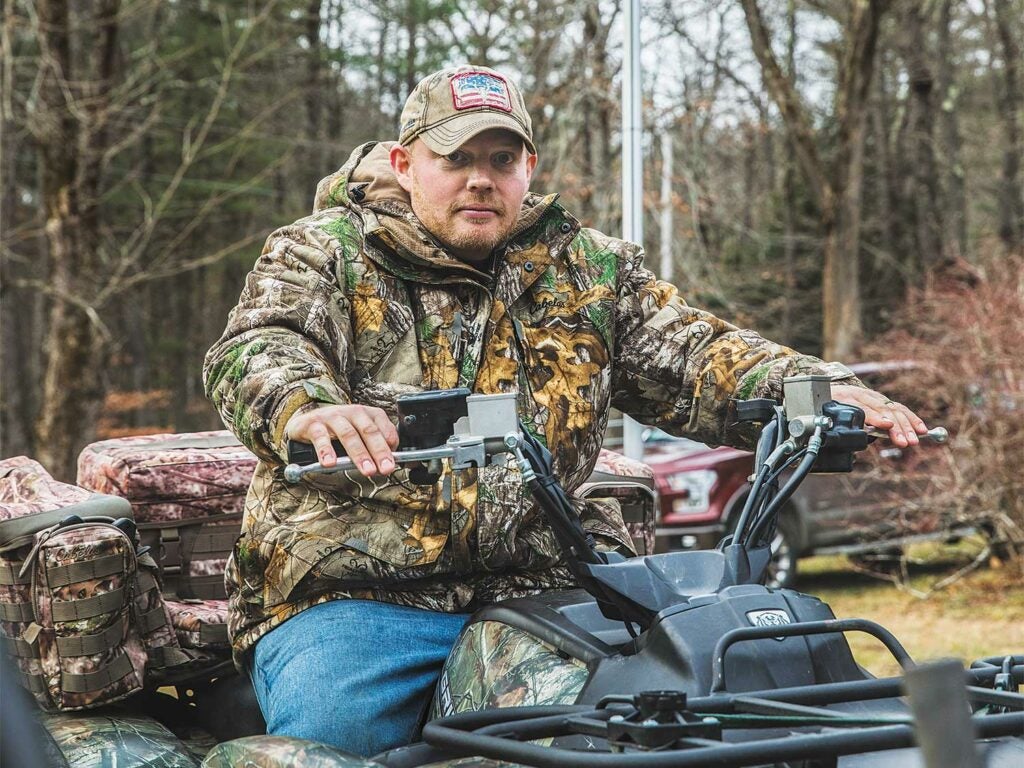
Nate getting ready to take the quad out of camp. Little Outdoor Giants
“I was in the Army,” he tells me. “I still miss it.”
I grab my bag from the trunk, thinking about the extraordinary group of guys still back at deer camp.
“I know what you mean,” I tell him.
Editor’s Note: This story originally ran in Outdoor Life magazine in 2019.
The post Bond of Brothers: Military Vets Find Healing in the Hunt appeared first on Outdoor Life.
By: Chuck Thompson
Title: Bond of Brothers: Military Vets Find Healing in the Hunt
Sourced From: www.outdoorlife.com/military-vets-healing-deer-hunting-camp/
Published Date: Mon, 22 Apr 2019 17:20:46 +0000
----------------------------------------------
 Backyard GrillingWeekend WarriorsAdvice from DadBeard GroomingTV Shows for Guys4x4 Off-Road CarsMens FashionSports NewsAncient Archeology World NewsPrivacy PolicyTerms And Conditions
Backyard GrillingWeekend WarriorsAdvice from DadBeard GroomingTV Shows for Guys4x4 Off-Road CarsMens FashionSports NewsAncient Archeology World NewsPrivacy PolicyTerms And Conditions
